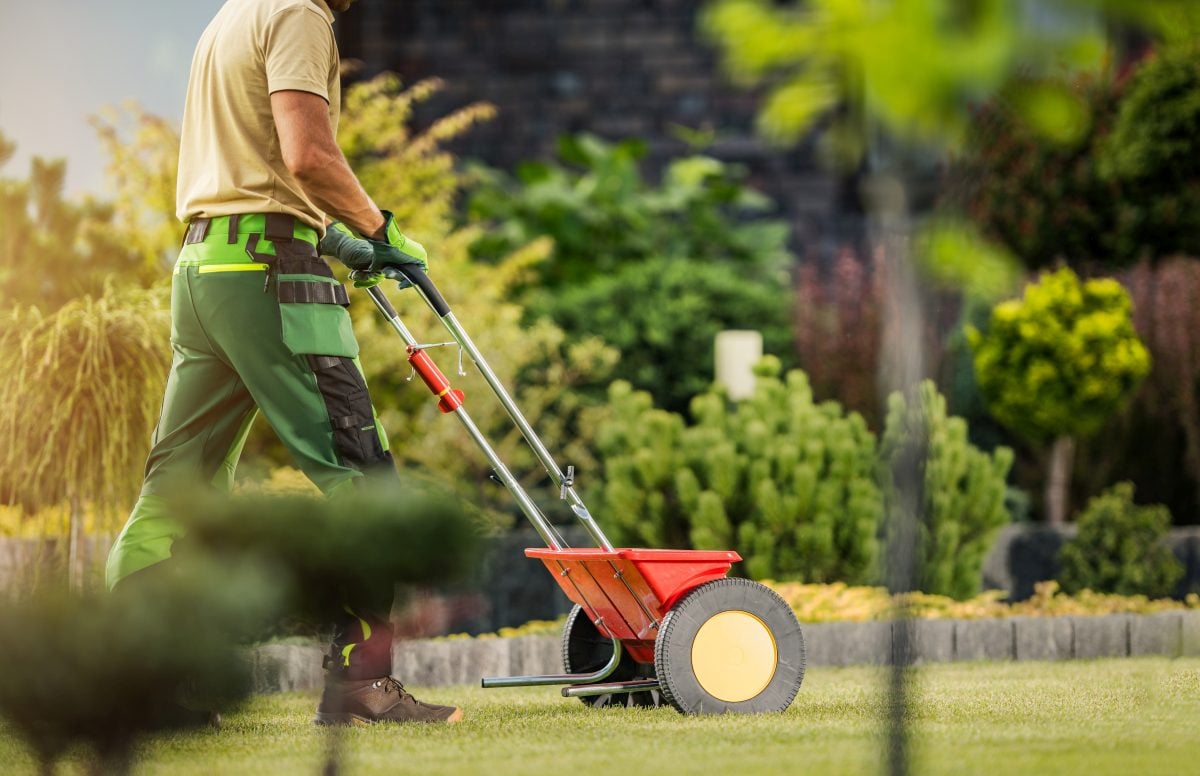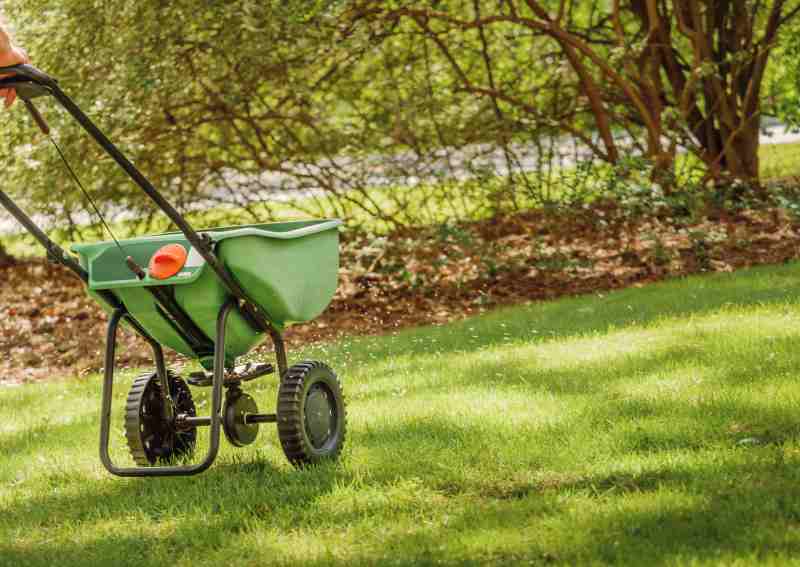
The best time to fertilize bermudagrass is in summer, its most active growing season. Bermudagrass may also benefit from fertilizer in late spring and fall, however, this depends on the results of a soil test.
Each season of the year sees different fertilizer requirements for your lawn. Nitrogen is highly important for bermudagrass in summer, but less necessary in spring, and rarely recommended in fall. Instead, soil tests may recommend light nitrogen in spring, and phosphorus or potassium in fall.
The bottom line? A soil test will be your best friend when it comes to making a fertilizer schedule that suits your bermudagrass lawn’s nutritional needs.
When to Fertilize Your Bermudagrass Lawn
The best time to fertilize any grass is during its active growth period. For bermudagrass, that growth period ranges from approximately late spring to early fall, growing most actively in summer.
Bermudagrass requires two to four pounds of nitrogen throughout the growing season, which can be applied over several applications in the summertime.
As for late spring and early fall, choose your fertilizer according to the results of a soil test. A soil test will tell you what nutrients are present in your soil and in what amounts. Use a fertilizer that has more of what your lawn needs and less of what it already has.
When to Fertilize Bermudagrass in Spring
The first fertilizer application of the year for your bermudagrass lawn may come in late spring, depending on soil test results. A soil test may indicate no need for fertilizer in spring. If your soil test recommends nitrogen, it will likely be a very light amount.
Wait to fertilize until after your lawn has fully greened and recovered from winter dormancy (typically between April and May). If you fertilize too soon, in early spring for example, an unexpected frost may harm the new growth.
When to Fertilize Bermudagrass in Summer
In summer, your lawn will be experiencing the most growth, and therefore requires the most fertilizer. For a warm-season grass like bermudagrass, start your summer fertilizer regimen once local temperatures reach 75 degrees Fahrenheit.
As a general guideline, apply fertilizer to your bermudagrass lawn every four to six weeks throughout the summer. However, the exact number and frequency of your summer fertilizer applications depend on different factors in your landscape that affect your fertilizer’s effectiveness.
Here’s a simple summer fertilizer schedule to help you get started:
Early Summer: The first fertilizer application of the summer growing season will likely come in late May or June. Apply one-half to 1 pound of nitrogen per 1,000 square feet. Early in the season, phosphorus will be very important for strengthening your lawn’s root system after it comes out of dormancy. If your soil test indicates that your lawn is low in phosphorus, use a fertilizer high in it.
Mid Summer: In mid summer, from approximately late June to July, your lawn will be experiencing significant growth. Apply one-half to 1 pound of nitrogen per 1,000 square feet. Apply phosphorus and potassium only as indicated by your soil test.
Late Summer: In August, apply one-half to 1 pound of nitrogen per 1,000 square feet. Apply potassium only as indicated by your soil test. Potassium increases your lawn’s cold hardiness and disease resistance for its coming dormancy.
When to Fertilize Bermudagrass in Fall
Finally, your last fertilizer application for the year, if not in summer, would be around late fall. The most important nutrient for your bermudagrass going into winter is potassium, since it will increase your lawn’s cold hardiness for the coming dormancy.
The potassium application should come four to six weeks before the first expected frost of the year. Again, whether you need to apply potassium (and how much) is determined by a soil test.
Just like spring, it is not recommended to give your lawn nitrogen in fall unless a soil test deems it necessary. In most cases, bermudagrass lawns do not need nitrogen in fall.
How to Fertilize Your Lawn

There are a few basic steps you should follow whenever you fertilize your lawn. First, pick your fertilizer, then prepare your lawn, apply the fertilizer, and finally water in the fertilizer.
- Pick Your Fertilizer: The first step is to determine what fertilizer is best for your lawn. The best way to do that is with a soil test, which will tell you what nutrients your lawn needs. For more information, read here: Fertilizer Numbers: Why They Matter and What They Mean
- Prepare Your Lawn: In preparation for a fertilizer application, you should mow your lawn, water it, apply weed control and pest control, and possibly dethatch and aerate your lawn.
- Apply Your Fertilizer: When applying your fertilizer, apply an even coat and follow the instructions on the fertilizer’s container.
- Water Your Lawn: The final step is to water in your fertilizer. If you don’t, the fertilizer will just sit on your grass blades and possibly cause fertilizer burn. The fertilizer needs to reach the soil in order to be effective.
For a more detailed explanation, read our article on How to Fertilize Your Lawn
When Not to Apply Fertilizer
There are times when it’s not appropriate to apply fertilizer. For example, you should avoid a fertilizer application during high heat, or during heavy rain. Do not fertilize your lawn in these conditions:
- Heat: If you fertilize when it’s too hot out, you have a greatly increased risk of fertilizer burn. Don’t fertilize if your local temperature has consistently been above 85 degrees Fahrenheit recently.
- Drought: While it’s rare since bermudagrass is drought resistant, you should never fertilize when your lawn is in drought stress. Fertilizer can pull water from your grass’ roots and lead to increased stress and energy consumption to process the fertilizer.
- Dormancy: If you try to fertilize your lawn during dormancy, you’ll likely waste a good deal of the fertilizer, and you can throw off your grass’ growth period. Fertilizing during dormancy also carries an increased risk of fertilizer runoff.
- Wrong Seasons: If you fertilize during the wrong season, you can harm or kill fragile new growth.
- Weeds: If your lawn has excessive weeds, your fertilizer will make them stronger. Grassy weeds especially will benefit from your fertilizer and become even more of a problem.
- Rain: If it’s supposed to rain heavily, skip the fertilizer. The extra water can lead to fertilizer runoff, and your fertilizer won’t have the opportunity to absorb the nutrients.
FAQ About Fertilizer & Bermudagrass
Is Bermudagrass resistant to weeds?
Unfortunately, bermudagrass can be susceptible to weeds. If the conditions in your lawn aren’t right, your lawn can thin and weeds can start to take a foothold in your landscape.
Will fertilizer bring Bermudagrass out of dormancy?
No. Fertilizer can’t bring any grass out of dormancy alone, and fertilizing a dormant lawn is not advised. It’s best to allow your grass to come out of dormancy on its own rather than force it early.
How can I fix fertilizer burn?
The best way to fix nitrogen burn on your grass, also called fertilizer burn, is to water the spot and wait. The water will wash away the excess nitrogen and salts that are causing the spot, which will allow the grass to heal itself naturally.
For more information, read here: What is Fertilizer Burn?
Find Your Lawn Care Experts
Summer is the best time to fertilize most bermudagrass lawns. However, since each lawn is different, you need to pay close attention to environmental factors
If you need lawn care, contact lawn care professionals near you. They can take care of mowing and fertilizing your lawn for you so that you can enjoy your day.
Main Photo Credit: Tomasz Zajda / Adobe Stock